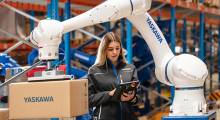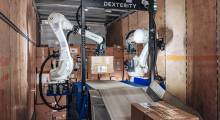An ongoing question among supply chain stakeholders, when it comes to global e-commerce bellwether Amazon, continues to be just how far it will spread its wings in terms of expanding its logistics and supply chain operations and processes.
Regardless of what people say or think, there are very real signs that Amazon is not going to sit on the sidelines and let logistics come to them, as, conversely, in many cases, it is really coming to logistics. Two quick examples of this include its 2012 $775 million acquisition of Kiva Systems, a developer of mobile-robotic solutions that automate e-Commerce order fulfillment and warehouse operations, and air cargo deals announced earlier this year, too, including one with Air Transport Services Group and another with Atlas Air Worldwide Holdings, among others.
And earlier this year Robert W. Baird & Co. analyst Colin Sebastian observed in a research note that his firm believes Amazon is in the early stages of building out larger-scale transportation and logistics operations to add capacity beyond existing providers, to lower logistics expenses, and ultimately, to offer specialized 3PL services to third parties.
“We believe Amazon’s ambitions in transportation and logistics are borne out of peak-period capacity constraints, and aims to alleviate some of the stresses on Amazon’s internal fulfillment/logistics network, particularly as network partners (e.g., UPS, FedEx) are unable to accommodate Amazon’s rapid growth,” he wrote. “Over time, we continue to believe the natural step for Amazon is controlling more of its own transportation and logistics, including additional air cargo and other transportation/operations, as these are almost a necessity to continue the rapid expansion of Prime and Prime Now.”
Sebastian also noted that Amazon spent around $11.5 billion on shipping in 2015, and explained that his firm estimates a $400 billion-plus market opportunity for Amazon in delivery, freight forwarding, and contract logistics.
All of this serves as a backdrop for what may or may not happen next. And it was spelled out to a degree in a Wall Street Journal report published last week, which explained how Amazon is “laying the groundwork for its own shipping business in a brazen challenge to America’s freight titans” (i.e. UPS and FedEx.
Citing unnamed current and former Amazon managers and business partners, the report explained that while Amazon has publicly said having a delivery presence is a logical way to add delivery capacity, its true objective is to eventually haul and deliver packages for itself and other retailers and consumers and subsequently redesign the typical seller and sender relationship and “build a massive delivery network” to compete with the likes of UPS and FedEx.
To be sure, both UPS and FedEx have said in earnings calls and published reports would be hard to pull off, due to financial and scaling up constraints.
And Stifel analyst Dave Ross told LM earlier this year that while his firm does not think Amazon will be a global integrator and offer its parcel delivery services broadly to others like UPS, FedEx, and DHL, it does believe Amazon will look to do more and more in-house each year, as its density grows.
Depending on Amazon’s next steps that may eventually turn out to be an understatement.
According to the WSJ report, a senior Amazon official was quoted as saying the company “is building a full-service logistics and transportation network effectively from the ground up.” And it added that Amazon could save $1.1 billion annually were it to stop using FedEx and UPS, based on an analysis from Citigroup Inc., coupled with keeping packages under its own control just over linger distances could save the company $3 or more on a typical delivery. It also pointed out that Amazon has recruited dozens of UPS and FedEx executives and UPS staffers in recent years and is buying long-haul truck trailers to ship by ground, building delivery drones, vetting managing ocean shipping, and increasing its focus on the last-mile deliveries market, too.
So, with all of these lofty logistics and supply chain aspirations intact, how realistic are they for Amazon?
Rob Martinez, president & CEO, Shipware Systems Corp, made it clear not to believe the hype, at least not for a while.
“FedEx and UPS continue to tell me that Amazon cannot replicate their network to any scale,” he said. “Nor do they have the delivery density to bend the cost curve. To date, Amazon’s efforts have been to support their own growth and minimize carrier dependency. They will continue to do that, as they expand their networks and develop greater delivery density. However, we do not foresee Amazon becoming a competitor to FedEx and UPS – delivering packages for companies outside of Amazon – at least for the next 4-5 years.”
And Jerry Hempstead, president of Hempstead Consulting, was even more direct in explaining that Amazon is simply taking care of Amazon, with the company having its own vision of how it wants its supply chain to operate and how they want the customer experience to be.
“I really don't see this as a threat to FedEx or UPS,” he said. “The majority of the hit UPS and FedEx were going to take is by a diversion of Amazon packages to other methods and means of transport and delivery. The biggest impact was the migration of the FedEx Smartpost to Amazon direct drops to USPS DDUs.”
Hempstead added that the emergence of Amazon logged delivery trucks and drivers takes high density deliveries away from the USPS and also gives a foot in the door to Amazon’s growing grocery business, which they see as the next game changer as FedEx and UPS are not delivering groceries.
“Amazon is forced to do business with FedEx and UPS,” he said. “They need these carriers for deliveries so Amazon does not have the delivery density to do much more than major metropolitan areas with their own trucks.”
With so many moving parts to this story, coupled with Amazon not really talking publicly about its full-fledged logistics vision, there is an expectation that things will change as time goes on. But it stands to reason that whatever does happen in regards to Amazon’s future as a logistics and supply chain player, it certainly will not be dull.
About the Author
Follow Robotics 24/7 on Linkedin
About the Author
Follow Robotics 24/7 on Linkedin
Article topics
Email Sign Up















